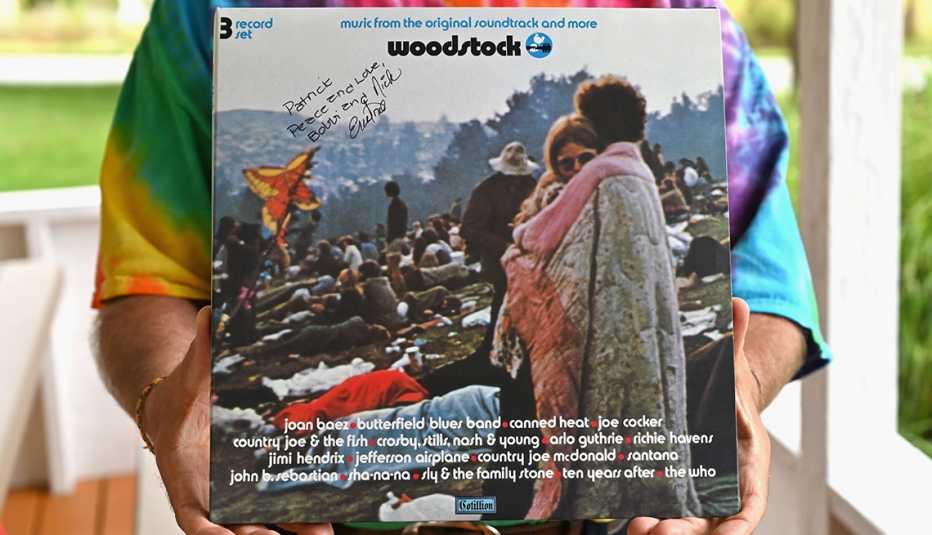Staying Fit


You've seen the photo. A young couple wrapped in a blanket stands in a muddy field amid a mass of hippies. Both identities are obscured. She's wearing large sunglasses. He's turned away from the camera. But the fortuitous snapshot swept the pair into Woodstock mythology.
As lovestruck Nick Ercoline and Bobbi Kelly snuggled against the Sunday morning chill on day 3 of the 1969 music festival, they were unaware that Life photographer Burk Uzzle had captured the moment. And they didn't see that defining image until everyone else did, when it appeared on the cover of the 1970 three-album Woodstock soundtrack.


AARP Membership— $12 for your first year when you sign up for Automatic Renewal
Get instant access to members-only products and hundreds of discounts, a free second membership, and a subscription to AARP the Magazine.
In May 1970, Nick and Bobbi went to the apartment of Jim “Corky” Corcoran, a friend who had joined them nine months earlier on their trek to Max Yasgur's farm in Bethel, New York.
"Corky was a two-legged music bible,” Nick says. “He had to be one of the first to buy the album when it came out, and we all got together, six or eight of us, to hear it. We were passing the jacket around when someone pointed out the staff with the orange and yellow butterfly. That belonged to Herbie, a guy from Huntington Beach, California. He was lost and having a bad trip, and we hooked arms with him until he was clear-headed. Then we saw the blanket. Oh my lord, that's us!"
At that moment, Bobbi says, “I realized I should tell my mother I had gone to Woodstock."
Nick and Bobbi were 20 and had been dating for three months when they went to the Woodstock Music and Art Fair. As boomers are toasting the festival's golden anniversary, the couple is also celebrating its 50th year of peace and love.
They were wed in 1971 and live in Pine Bush, N.Y., less than an hour from the festival site, where roughly half a million young people swarmed to see Jimi Hendrix, The Who, Jefferson Airplane, Santana and dozens more Aug. 15-18, 1969. It's now home to the Bethel Woods Center for the Arts, which is staging an anniversary blowout with headliners Ringo Starr & His All-Starr Band, Arlo Guthrie, Carlos Santana and John Fogerty. The Ercolines will attend as the event's Woodstock ambassadors.
"I feel fortunate that we're part of such an historic event,” Bobbi says. “The farther we get away from Woodstock, the more we realize how significant it was and what a big impact it had. It's part of who we are."
In the summer of 1969, Nick was between college semesters in Middletown, N.Y., working days in construction and nights as a bartender at Dino's Bar and Grill, “a great place to meet girls."
He met Bobbi there, and the two became inseparable.
When local media began buzzing about Woodstock traffic jams on Friday, Aug. 15, the first day of the festival, Nick, Bobbi, Corky (a Vietnam vet and ex-Marine who hoped he'd land a security job at the festival) and pals Cathy Wells and Mike Duco impulsively decided to head to Bethel, roughly 40 miles northwest. They left early Saturday morning.
"We heard on the news that thruway 17 was closed down,” Nick recalls. “They said, ‘If you're planning to come, don't.’ So what does any 20-year-old do? We went for it. Corky borrowed his mother's 1965 Chevy Impala station wagon, white with red interior. It was a land yacht."
They encountered state police and roadblocks, but as locals experienced with the back roads, they forged on, following the Delaware River and driving around barricades, across backyards, through private roads until they were forced to abandon the car five miles from the festival.


































































More on Politics
Woodstock Remembrances: Personal Stories From AARP Members
Personal stories about peace, love and music experienced at the 1969 festivalHow Woodstock Affected the Lives of One Extended Family
Boomers recall the events of 50 years ago
Woodstock: Where Are They Now?
Fifty years after the iconic festival, many of its top rockers still are making beautiful music